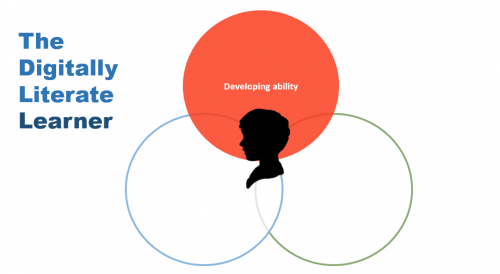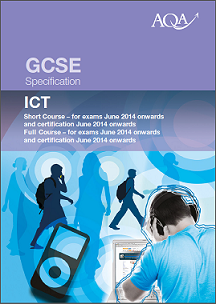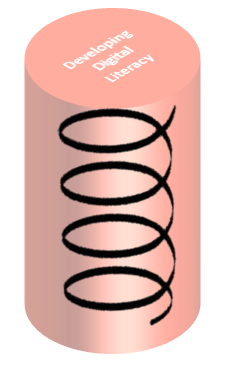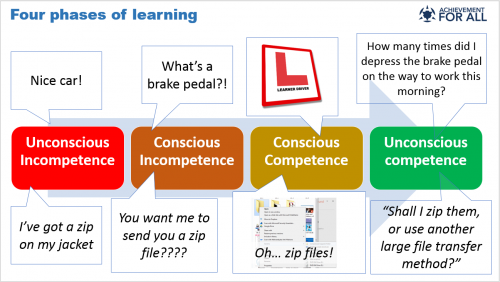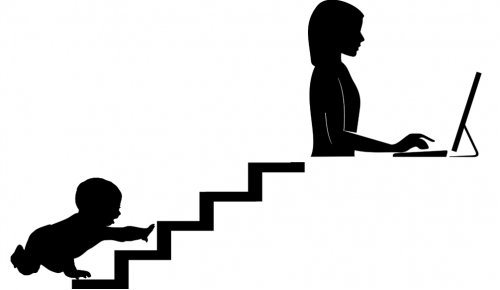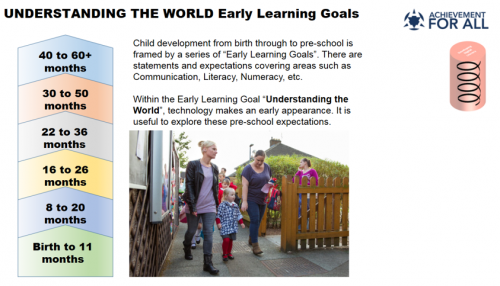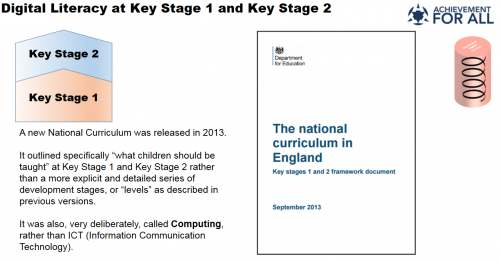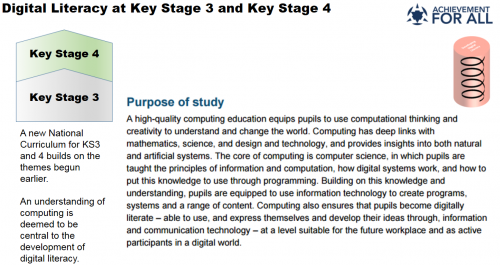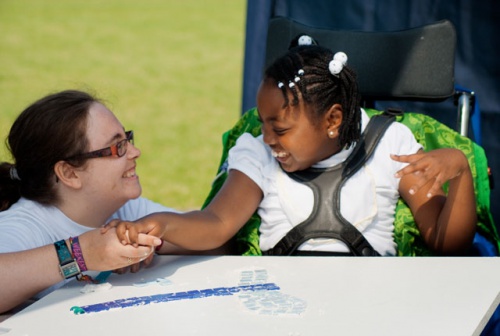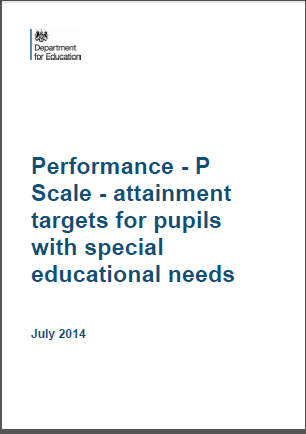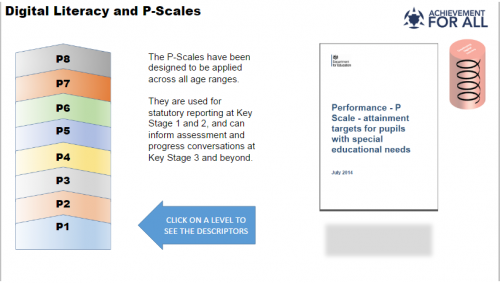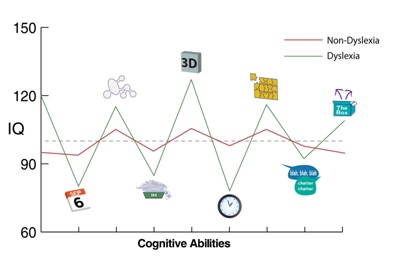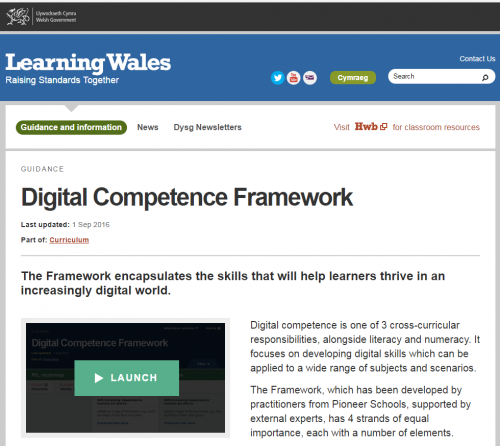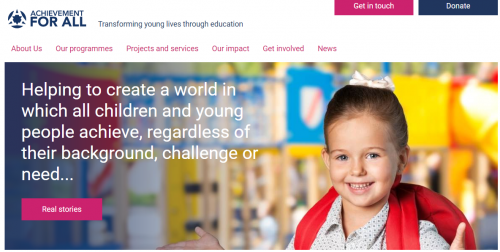Developing a Digitally Literate Learner
Contents
- 1 Description
- 2 Module 1: Digital Literacy: a Body of Knowledge, or a Life Skill?
- 3 Module 2: The (Digital) Learning Journey
- 4 Module 3: Digital Literacy in the context of Special Education Needs and Disabilities (SEND)
- 4.1 No assumptions must be made about a child or young person's digital capabilities, just because they may have special educational needs or a disability.
- 4.2 What is the P-Scale?
- 4.3 The P-Scale steps in Computing
- 4.4 Appreciating and understanding a "spikey profile"
- 4.5 Chris Nolan (6 September 1965 – 20 February 2009)
- 4.6 Remind students and staff about the accessible features available across Office 365 with this convenient one page document.
- 4.7 What you can do
- 5 Module 4: A Progressive Digital Competence Framework from Wales
- 6 Quiz
- 7 Source
Description
Digital Literacy is a set of life skills as well as a body of knowledge.
This course gives you an opportunity to reflect on a learning journey: the progressive growth of digital competency, from pre-school to adulthood.
Achievement for All stands for inclusive practice: We feature here resources such as the the P-scales for supporting progression if a child or young person has special education needs. We also explore the concept a "spikey profile" in the context of neuro-diversity.. and the absolute necessity to have high expectations at all times for all learners.
Finally, a model defining and contextualising the progressive development of digital competence, developed in Wales, UK, (DCF- Digital Competence Framework) is presented for critical reflection.
Disclaimer: Achievement for All acknowledges and celebrates the abundant sources of information advice and guidance that are available on the world wide web. Whilst every care is taken to check the credentials and authenticity of these third party sources, Achievement for All accepts no liability for any content referred to and supplied by such third party sources.
Module 1: Digital Literacy: a Body of Knowledge, or a Life Skill?
Take a look at a GCSE* ICT Examination Subject Specification (especially if you are a primary (elementary) teacher or a non-IT specialist in secondary (middle/high) schools!). It lays out clearly and precisely what is expected of a successful 16-year-old candidate in terms of knowledge and skills. The specification is detailed. A large body of knowledge has to be recalled under test conditions to get a good grade. This learning must be applied within written exam conditions in order to demonstrate understanding.
Another important point to note is that a GCSE is seen as a bridge to further study at A-Level, BTEC and beyond.
It may surprise you how much of this content you have intuitively picked up, as you have learned to navigate your way around the digital world without direct tuition.
You also may not have been aware of where you have gaps in basic knowledge- without structured tuition, you simply don't know what you don't know!
*High School Diploma equivalency level in America
Digital literacy is not just about skills. Digital Literacy is not just knowledge. Digital literacy is both!
Digital Literacy is not about acquiring knowledge that can be applied under test conditions. Neither is digital literacy simply about skills (typing speed, using consoles and touch screens, cutting and pasting data and text).
Digital literacy is about the application of knowledge and skills, in all aspects of learning, work and living. And, just like literacy and numeracy, your competency is gradually built up in a spiral of learning, progressively building on firm foundations, with new learning and skills being applied as previous learning becomes intuitive and unconscious.
Think about the steps you may have gone through when learning to drive...
Reflective Questions
- Discuss the four phases of learning (Unconscious Incomplete, Conscious Incompetence, Conscious Competence, Unconscious Competence) with a colleague.
- Think about a vulnerable or disadvantaged learner in your setting. At which phase is learning stalled or being blocked (unconscious incompetence, conscious incompetence, etc. etc.)?
- Is there a skill or competency exhibited by the learner where unconscious competence is being displayed already (in sport, music, on-line gaming, riding a bike, or other social and leisure activities)?
- Discuss how you can attempt to overcome the barriers to learning you are seeing by deconstructing what they are good at, and how they got there, then applying this understanding to other areas of learning?
Module 2: The (Digital) Learning Journey
The Learning Journey
As educators, we tend to concentrate on the phase of learning that we are most intimately engaged in.
This is perfectly understandable.
We seldom get an opportunity to reflect on the entire learning journey.
As a primary (elementary) specialist, however, it is important to understand some of the pre-school cognitive development steps a young child should make before they arrive in your setting. It is also important to appreciate how their knowledge skills and dispositions should continue to develop after they have left your care.
As a secondary (middle/high) specialist, it is important to understand the learning journey prior to transition into your setting.
Finally, when working with vulnerable and disadvantaged children and young people, or those with SEND (Special Education Needs and Disabilities), understanding the "big picture" will help you identify what are the critical learning needs, where are the specific barriers to learning, and how to overcome them.
To illuminate the journey, we will start by looking at the statutory and non-statutory frameworks that exist in England.
From Birth to 5 Years of Age
A series of "Early Learning Goals" give guidance to pre-school educators regarding progression and expectations in a number of critical areas.
Click here to open the interactive
Even at this early very early developmental stage, technology is referenced. However, it is rightly set within a social and interactive context, relating to a child's developing understanding of the world in which they live.
From 5 to 11 Years of Age
The recent changes to the National Curriculum in England have been significant in all areas of the primary curriculum.
There has been a profound move away from "levels" towards the importance of defining "age-related expectations", on a pathway designed to ensure that every child is "secondary-school ready" by the time they leave primary provision.
CLICK HERE TO OPEN THE INTERACTIVE
From 11 to 16+ Years of Age
The English National Curriculum outlines "what learners need to be taught" until the end of Key Stage 3, and then the opportunities that should be offered through a curriculum and qualification offer 14-16+.
After this stage, some young people may choose to specialise into IT GCSEs, A-Levels and vocational BTEC qualification courses.
Click here to open the interactive
Others will not... but with digital technologies becoming ubiquitous, in fact, almost essential, for life-long learning, living and employment, all learners must continue to be challenged and motivated to grow their digital literacy through school, through college and university, throughout their lives.
Module 3: Digital Literacy in the context of Special Education Needs and Disabilities (SEND)
No assumptions must be made about a child or young person's digital capabilities, just because they may have special educational needs or a disability.
Every child is unique. Every illness, dysfunction or disability comes in a spectrum of symptoms or expression, sometimes causing global issues that impact on every aspect of a child's development, and sometimes causing specific issues that may take time and effort to understand and assimilate.
Sometimes, access to the appropriate assistive technologies, or skilled pedagogy to grow a particular digital learning competency or disposition, can transform life outcomes for a child or young person with SEND.
What is the P-Scale?
The P-Scale was created to support children and young people who cannot access the National Curriculum.
It is used for statutory reporting in English and Mathematics at Key Stages 1 and 2, and provides a framework for teacher assessment, and reporting to parent and carers, at all other stages.
Children and Young People with Profound and Multiple Learning Difficulties (or certain severe Specific Learning Difficulties) my struggle to perform above P3.
P4-8 describes small incremental steps in terms of expression and capability that can form the basis of curriculum and learning progression.
There should be no lack of aspiration, nor acceptance that some form of progress is not possible.
CLICK HERE FOR MORE INFORMATION
The P-Scale steps in Computing
CLICK HERE TO OPEN THE INTERACTIVE GUIDE
Appreciating and understanding a "spikey profile"
Certain special educational needs are very complex. A dysfunction in one particular area of neural processing might mask average, or above average, capabilities and abilities in other areas.
The classic example often given involves Cerebral Palsy. Issues with the way the brain controls muscle activity produces degrees of movement disability, and can severely impact on speech and language. And yet cognition (thinking and processing) can be unaffected. This applies to Dyslexia as well.
Image used with kind permission from http://www.geniuswithin.co.uk/
ASD (Autism Spectrum Disorder) is another example where specific disorders in neural processing may mask 'normal' (often described as neuro-typical) functions... and in some cases, enhanced and super-enhanced abilities in certain areas.
ASD is often described as a 'triad of impairment'. The diagnostic 'key' is that there are deficits in Social Imagination, Social Communication and Social Relationships. Nevertheless, a child might be average or above average in terms of specific thinking skills (see 'The hidden potential of autistic kids' Scientific American 2011).
These examples illustrate "spikey profiles", and how careful diagnosis and observation, whilst highlighting the extent and depth of impairment in some areas, can also shed light on other aspects of neural function that are average, or sometimes, well above average. Today, as a society, we are developing the concept of neurodiversity, where neurological differences are to be recognized and respected as any other human variation.
Chris Nolan (6 September 1965 – 20 February 2009)
Christopher Nolan is an Irish author. He was born with cerebral palsy, from birth complications, and writes using a special computer. He had been deprived of oxygen for two hours when he was born, but his mother believed he could understand what was going on and used to teach him at home. Eventually, they discovered a drug that allowed him to move one muscle in his neck so they attached a ‘unicorn device’ to his forehead and he learned to type. Nolan has never spoken or signed a word in his life, yet his poetry has been compared to that of Joyce, Keats, and Yeats. At fifteen, his first book Dam-Burst of Dreams was accepted for publication.
Visit https://www.disabled-world.com/ to read some inspirational stories (like the one of Chris Nolan, above). Share some of these with your students to celebrate diversity, and achievement against the odds.
The targeted use of digital technologies and development of digital literacy, coupled with an awareness of a child's "spikey profile", can transform the life chances of individual children and young people, whether they have profound learning difficulties, or whether cognitive impairments are marginally expressed, and the child has no identified special education need. The latter may be the case, for example, where neglect and social deprivation during childhood has led to developmental delays that can hold a learner back for their entire schooling life.
Never before in human history has the power of technology to overcome impairment been greater, to personalise learning in an extremely targeted way. This capacity is likely to grow exponentially in the next decade.
Remind students and staff about the accessible features available across Office 365 with this convenient one page document.
O365 Education - Learning Tools one pager.pdf
What you can do
This activity can be applied to any setting (primary, secondary, special, etc.), and can be conducted as an individual or collaborative action research project.
STEP 1 - CHOOSE A LEARNER
Choose a learner with an identified special education need, or a pupil in the identified Pupil Premium Cohort (in England, these are learners that have been identified has coming from socially disadvantaged households).
STEP 2 - REFLECT UPON THEIR BARRIERS
Reflect upon their barriers to learning. If uncertain, liaise with SENCo (Special Education Needs Manager) or another Learning Manager to fully appreciate the key issues that apply to the learner.
STEP 3 - LOOK AT THE DIGITAL LITERACY CRITERIA
Look at the digital literacy criteria illustrated above. Is the learner exhibiting age-related expectations in terms of the expression of digital literacy? If not, consider the adjacent lower level and try to identify which area needs to be addressed (if the learner has profound or significant learning difficulties, do the same activity using the P-Scale information).
STEP 4 - TRY TO SELECT AN AREA
Try to select an area of digital literacy that, if supported and further developed, might help the learner "close the gap" in other areas of study. Have a learning conversation with the child or young person, or their family.
STEP 5 - SUPPORT THE DEVELOPMENT
Support the development of the identified digital literacy skill (with help from IT specialist in school, or through Microsoft training offer), and help the learner to apply it. This may necessarily include the personal development of your digital literacy skills and knowledge too! Evaluate progress. Share learning and achievements. Repeat with other learners.
Module 4: A Progressive Digital Competence Framework from Wales
Wales has launched an ambitious plan to embed the teaching literacy, numeracy and digital competency into the heart of every learning experience, from nursery and reception into Year 11. Every teacher is responsible; all teaching professionals contribute to this ambitious plan. The strength of this model is that it is not just about knowledge or skills: it is about how knowledge and skills are expressed and applied.
It is a fully inclusive framework, beginning with RfL levels (Routes for Learning), designed for children and young people with sometimes profound learning difficulties) and extending through to Year 11 expectations (15-16 years old). The higher levels can also be used to extend, stretch and challenge more able learners.
Click here to link to Learning Wales website
Visiting the Learning Wales Curriculum website will help you stay abreast of the latest developments, and learn from developing practice in the Welsh Pioneer Schools.
The Welsh DCF articulates the growth of digital competence in four domains or strands
Presented here is the innovative conceptual framework for the growth of digital citizenship.
CLICK HERE TO OPEN THE INTERACTIVE GUIDE
What you can do
This activity can be applied to any setting (primary, secondary, special, etc.), and can be conducted as an individual or collaborative action research project.
These resources can be used in a number of ways:
- To review current curriculum provision against age-related expectations
- To review the progress of an individual child (or group of children) against age-related expectations
- As an analysis framework to profile a child, and ascertain in which areas they are meeting age-related expectations, performing beyond and/or performing below expectations.
- To review your own personal digital competencies!
Find out more about Achievement for All: visit our website
Also! We'd like to hear your views on growing and nurturing the digitally literate learner. If you have inspirational stories, examples of your best practice, or steps that you are personally going to take after completing this module, please leave a comment.
